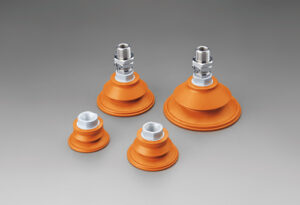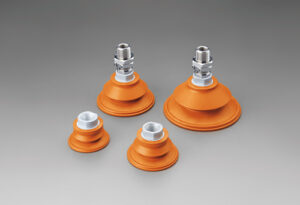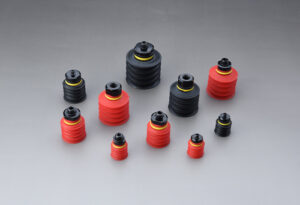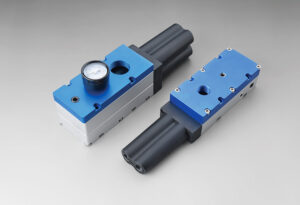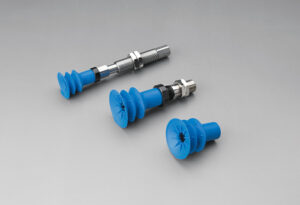1.Bionic suction cup
As conventional suction cups are primarily for specific workpiece requirements, they mainly apply to flat and smooth planes and adapt to a few workpiece shapes. Domestic and foreign scholars have researched bionic suction cups to adapt to various workpiece clamping requirements based on marine mollusk inspiration.
Frank W. Grasso et al. analyzed the characteristics of octopus suction cups and pointed out that the manufactured artificial suction cups must satisfy three functions.
Artificial suction cups must satisfy three functions
(i) A funnel-like structure to provide a surface seal to fit any geometric surface;
② with the artificial suction cup structure can generate the negative pressure required for suction;
③ External muscles allow the surface to be sucked to rotate freely with the robot arm.
Zhou Likun et al. used the bionic and vacuum adsorption principles based on three bionic concave funnel suction cup structure models, combined with the characteristics of octopus suction cup parallel or parallel standard layout. They found through mechanical analysis that the tread suction cup pattern mostly adsorbs effectively with the ice surface, which can ensure sufficient adsorption force and improve the anti-skid ability of the car on the ice surface.

However, artificial processing is complicated because the number of octopus sucker muscle tissue is huge, closely filled, and has three-dimensional structural characteristics. U.S. scientists used composite 3D printing technology to make artificial suction cup samples. Each suction cup is only the size of a fingernail cap and used such a suction cup on land for suction clinging experiments. Scientists predict that such suction cups may improve performance underwater, as the water pressure can provide more significant pressure.
For the actuating end of the robot, manufacturing an artificial device like an octopus suction cup requires making many artificial muscle units, such as octopus tissue, which is technically complex and requires higher processing costs. Jingping Hou et al. studied the bionic structural properties of squid sucker to find a more achievable structure. They used it as the basis to design and fabricate an artificial squid sucker that can be used as the end-effector of a soft robot.
With the integration of pneumatic technology, biotechnology, and material technology, bionic vacuum suction technology is emerging. These emerging bionic suction cups use artificial elastic materials to simulate the deformation and suction of marine soft-bodied organisms. Compared with conventional suction cups, bionic suction cups consume less energy, are more adaptable, and have good prospects for development.
2.Deformation of suction cups to produce vacuum
Changing the suction volume and, thus, the pressure in the suction chamber is another method of vacuum generation. The elastomer material encloses a closed cavity, and the deformation of the elastomer material changes the volume of the inner chamber of the suction cup to generate negative pressure. Bishan Hu et al. designed a biased SMA spring actuator-driven bionic harmful pressure suction cup with a bias spring, established this suction cup’s theoretical model, and verified the theoretical model by experiment. The negative pressure inside the suction cup can reach about 12kPa, and less energy consumption.
3.Optimization of suction cup material
In addition to negative pressure suction and changing the suction volume to obtain a specific vacuum level, the Vacuum Suction Cup‘s material properties and the suction surface microstructure will also influence the suction effect.
Follador et al. used insulating elastic material to simulate the structure of muscle columnar fiber bundles to form a tight suction and seal. tramacere et al. compared the effect of the tiny fold structure of the suction surface on the suction effect. In underwater static suction experiments, the type of liquid and impurities, water temperature, and the material properties of the suction surface of the suction cup would affect the suction effect. According to the anatomical structure of octopus suction cups, small suction cup materials have special features besides relying on the cavity at the top and the soft side to create pressure (difference) to form an airtight vacuum. Based on microscopic and micro-CT (micro-computed tomography) observations, the sides and edges of the suction cups grow tiny coaxially arranged fiber tufts that help create a dense vacuum on the uneven surface of the water bottom.
With the deepening of research and the progress of technology, the rational use of new technologies and methods can optimize the suction cup structure, enhance the suction effect, and promote the development of contact vacuum suction technology in the direction of multi-condition adaptation, multi-shape clamping, and high efficiency and energy saving.


